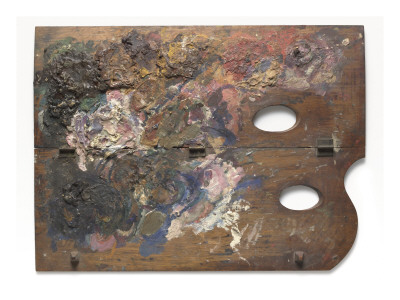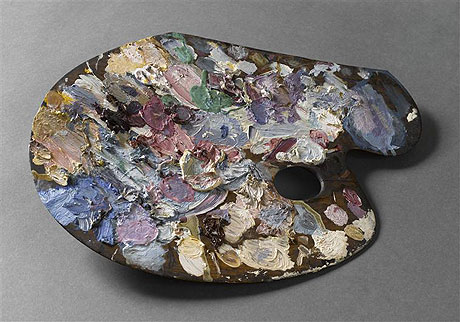On 3 Nov, 2011 With
Gérôme’s Palette Jean-Léon Gérôme was a French painter and sculptor in the style now known as Academicism. Lead white Cadmium yellow Yellow ochre Mars yellow Vermilion Light red Burnt sienna Rose madder Purple lake (laque pourpre) Emerald green Mineral blue* Cobalt blue light Ivory black *According to Vibert (La science de la peinture, p. 288), mineral blue (bleu minéral) is a pigment with the same chemical composition as Prussian blue.
Read More
On 19 Oct, 2011 With
Van Gogh’s palette Why preserve an artist’s palette? The daubs of raw pigment or the mixes left in position can be an intriguing index to the working method and the mind of the artist. And most, once the status of art had been elevated above the realms of mere craft, would paint themselves palette in hand. Where and how colour is laid can convey emotion, psychology, religious significance. “The whole value of what you are about” wrote John Ruskin in his Elements of Drawing, first published in 1857 “depends on colour. If the colour is wrong, everything is wrong: just as, if you are singing, and sing false notes, it does not matter how true your words are.” In a letter to…
Read More
On 5 Sep, 2011 With
Palettes of Famous Artists Gauguin believed in: “Pure colour! Everything must be sacrificed to it.” Yet, overall, his tones were muted, and quite close together. Marion-Boddy Evans draws our attention to a portable palette found in his painting studio after he died, from which it would appear Gauguin didn’t lay out his colours in any particular order. Nor does he seem to have ever cleaned his palette, instead mixing fresh colours on top of dried-up paint.
Read More
On 1 Sep, 2011 With
Palettes of Famous Painters Of Gustave Moreau, the art critic Charles Blanc, whose writings (still essential reading) and triangle based colour-system are considered the most influential texts on colour theory, wrote in Le Temps, 1881: “One would have to coin a word for the occasion if one wished to characterise the talent of Gustave Moreau, the word colourism for example, which would well convey all that is excessive, superb and prodigious in his love for colour. … It is as if one were in the presence of an illuminator who had been a jeweller before becoming a painter and who, having yielded to the intoxication of colour, had ground rubies, sapphires, emeralds, topazes, opals, pearls and mother of pearl to…
Read More
On 25 Aug, 2011 With
Palettes of Famous Painters: The Degas palette The Degas palette above is from earlier in his career, when he was still using the earthy tones common to the Dutch tradition. It lightened considerably in later years as his subject matter altered. Although there are a number of prescribed ways in which to lay out oil paint – light to dark; as per the colour wheel; basic palettes of three colours and white – all artists begin by lining up pigments at the top of the palette and use the remainder of its space for mixing.
Read More



